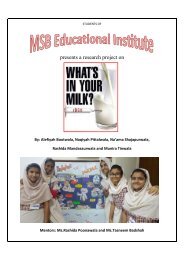Zoo Project
The Research Question for our study was “Is Jijamata Udyan capable to keep wild animals?” The ‘Recognition of Zoo Rules, 2009 with (Amendment) Rules, 2013’ by the ‘Central Zoo Authority’ (CZA) provides requirements for zoo and animal maintenance. We hypothesised that the zoo would not be following these rules, and therefore is not capable to keep the animals. We created a framework to check whether the zoo is following the rule. Our hypothesis was proved right. Jijamata Udyan is not providing proper care to most of its animals, such as portable water, safety from human disturbance, natural environment in cages or clean cages. Some of the animals might be physically ill or mentally disturbed. The zoo not being an education facility for conservation and environment to the Mumbai public, either through information boards near cages, information at the gate, or activities for the public to learn. We believe this research is significant for Mumbai because firstly, as this is the only zoo in Mumbai, and it receives around 15,000 daily visits, it should be a conservation and environmental centre and education facility, which it is not. Secondly Mumbai is biggest city in India, it is not good for the city or the country for the zoo not to be capable or follow rules. Further research and awareness campaigns could help improve conditions in the Zoo. While Jijamata Udyan is planning to renovate the zoo it should be asked to give guarantee that they will take care of its current animals.
The Research Question for our study was “Is Jijamata Udyan capable to keep wild animals?” The ‘Recognition of Zoo Rules, 2009 with (Amendment) Rules, 2013’ by the ‘Central Zoo Authority’ (CZA) provides requirements for zoo and animal maintenance. We hypothesised that the zoo would not be following these rules, and therefore is not capable to keep the animals. We created a framework to check whether the zoo is following the rule. Our hypothesis was proved right. Jijamata Udyan is not providing proper care to most of its animals, such as portable water, safety from human disturbance, natural environment in cages or clean cages. Some of the animals might be physically ill or mentally
disturbed. The zoo not being an education facility for conservation and environment to the Mumbai public, either through information boards near cages, information at the gate, or activities for the public to learn. We believe this research is significant for Mumbai because firstly, as this is the only zoo in Mumbai, and it receives around 15,000 daily visits, it should be a conservation and environmental centre and education facility, which it is not. Secondly Mumbai is biggest city in India, it is not good for the city or the country for the zoo not to be capable or follow rules. Further research and awareness campaigns could help improve conditions in the Zoo. While Jijamata Udyan is planning to renovate the
zoo it should be asked to give guarantee that they will take care of its current animals.
You also want an ePaper? Increase the reach of your titles
YUMPU automatically turns print PDFs into web optimized ePapers that Google loves.
After doing secondary research, reading newspaper articles, we felt that the zoo itself is not capable to handle wild animals. We read about the<br />
‘World Association of <strong>Zoo</strong>s and Aquariums’ (WAZA), an organization which tells countries how to take care of animals. India is also a member<br />
of this, and all zoos in India are under the ‘Central <strong>Zoo</strong> Authority’ (CZA). CZA has rules for zoo management.<br />
The ‘Recognition of <strong>Zoo</strong> Rules, 2009 with (Amendment) Rules, 2013’ (Annex 1) provides requirements and rules for how the zoo should be<br />
maintained and the animals should be kept. As our hypothesis is that the zoo is not capable to handle its wild animals, we thought that they<br />
would not be following the rules.<br />
We decided that since we were not able to speak to the zoo authority, we would observe and make our own analysis. Since our observations<br />
may be right or wrong, or biased, we would check if the zoo was following the national rules or not.<br />
To start with, we read the regulations, and made a list of points which we could check ourselves, to our best understanding, and we visited the<br />
zoo to check them. We visited the zoo on a weekend, because most people visit that time, and we could observe if people are disturbing the<br />
animals.<br />
We divided points into 2 parts:<br />
i. Applicable to the zoo in general, which we checked ourselves. (Annex 2)<br />
ii. List of points which applied to each cage. We made an observation table out of these points, to check them. (Annex 3)<br />
We visited each cage and observed the animals and the cage according to our table. We made a note of our observation, and also took a<br />
photograph where we could.<br />
We visited 25 cages in total. We have counted each animal’s cage as a separate one. For example, in the small bird enclosure, we have counted<br />
separate cages for the dove, parrot etc, as despite being in the same big enclosure, they had different cages. Because there was no map or<br />
directions available we were not able to be sure if we have covered all cages or not.<br />
5






